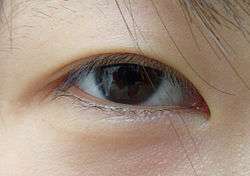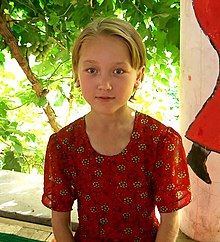Epicanthic fold
An epicanthic fold or epicanthus[6] is a skin fold of the upper eyelid that covers the inner corner (medial canthus) of the eye.[2] However, variation occurs in the nature of this feature and the possession of 'partial epicanthic folds' or 'slight epicanthic folds' is noted in the relevant literature.[7][8][9] Various factors influence whether epicanthic folds form, including ancestry, age, and certain medical conditions.
| Epicanthic fold | |
|---|---|
 A South Korean person with the skin fold of the upper eyelid covering the inner angle of the eye | |
| Details | |
| Synonyms | Epicanthal fold, epicanthus, eye fold,[1] Mongoloid fold,[2] palpebronasal fold[3] |
| Pronunciation | /ˌɛpɪˌkænθɪk ˈfoʊld/[4] |
| Identifiers | |
| Latin | Plica palpebronasalis[5] |
| TA | A15.2.07.028 |
| FMA | 59370 |
| Anatomical terminology | |
Etymology
Epicanthus means 'above the canthus' with canthus being the Latinized form of the Ancient Greek κανθός : kanthós, 'corner of the eye'.
Classification
Variation in the shape of the epicanthic fold has led to four types being recognised:
- Epicanthus supraciliaris runs from the brow, curving downwards towards the lachrymal sac.
- Epicanthus palpebralis begins above the upper tarsus and extends to the inferior orbital rim.
- Epicanthus tarsalis originates at the upper eyelid crease and merges into the skin near the medial canthus. This is the type most often found in East Asians.
- Epicanthus inversus runs from the lower eyelid skin over the medial canthus and extends to the upper lid.[10]
Ethnogeographic distribution
High-frequency populations

The highest frequency of occurrence of epicanthic folds is found in specific ethnicities: East Asians, Southeast Asians, Central Asians, North Asians, Polynesians, Micronesians, Native Americans (including Mestizos), the Khoisan, and the Malagasy. Among South Asians, they occur at very high frequencies among the Bhutanese,[11] Northeast Indians,[11] Kirati, and certain Adivasi[11] tribes of eastern India.
In some of these populations the trait is almost universal, specifically in East Asians and Southeast Asians, where a majority, up to 90% in some estimations, of adults have this feature.[12]
Lower-frequency populations

Epicanthic folds also occur, at a considerably lower frequency, in other populations: Europeans (e.g., Scandinavians, English, Irish,[13] Hungarians, Russians, Poles, Lithuanians, Finns, Estonians and Samis),[14][15] South Asians (Sinhalese,[16] Bengalis[11] among other groups in eastern South Asia),[11] Nilotes, Cushitics and Amazigh people.[17] The degree of development of the fold between individuals varies greatly, attribution of its presence or absence is often subjective, and its frequency varies clinally across Eurasia. Its use, therefore, as a phenotypic marker to define biological populations is debatable.[18]
Possible evolutionary function
The epicanthic fold is often associated with greater levels of fat deposition around the eyeball, a feature most accentuated in native North Siberian, Aleut and Inuit populations. The adipose tissue is thought to provide greater insulation for the eye and sinuses from the effects of cold, especially from freezing winds, and to represent an adaptation to cold climates. It has also been postulated that the fold itself may provide a level of protection from snow blindness. Though its appearance in peoples of Southeast Asia can be linked to possible descent from cold-adapted ancestors, its occurrence in various African peoples precludes a cold-adaptive explanation for it appearing in the latter groups. The epicanthic fold found in some African people has been tentatively linked to protection for the eye from the high levels of ultraviolet light found in desert and semi-desert areas.[19]
Other factors
Age
Many fetuses lose their epicanthic folds after three to six months of gestation.[20] Epicanthic folds may be visible in the development stages of young children of any ethnicity, especially before the nose bridge fully develops.[21]
Medical conditions
The epicanthic fold is sometimes found as a congenital abnormality. Medical conditions that cause the nasal bridge not to mature and project are associated with epicanthic folds. About 60% of individuals with Down syndrome (also known as trisomy 21) have prominent epicanthic folds.[22][23] In 1862, John Langdon Down classified what is now called Down syndrome. He used the term mongoloid for the condition. This was derived from then-prevailing ethnic theory[24] and from his perception that children with Down syndrome shared physical facial similarities (epicanthic folds) with those of Blumenbach's Mongolian race. While the term "mongoloid" (also "mongol" or "mongoloid idiot") continued to be used until the early 1970s, it is now considered pejorative and inaccurate and is no longer in common use about medical conditions.[25]
In Zellweger syndrome, epicanthic folds are prominent.[26] Other examples are fetal alcohol syndrome, phenylketonuria, and Turner syndrome.[27]
See also
- Blepharitis
- Epicanthoplasty, the surgical modification of epicanthic folds
- Human physical appearance
- Mongoloid
References
- "Eye fold".
- Das, Ram Narayan (1997). Sterling Dictionary of Anthropology. Sterling. ISBN 9788173590689.
- "Palpebronasal Fold - Medical Dictionary Search". Stedman's Medical Dictionary. 2006. Retrieved 1 October 2009.
- Wells, John (3 April 2008). Longman Pronunciation Dictionary (3rd ed.). Pearson Longman. ISBN 978-1-4058-8118-0.
- "AllRefer Health - Epicanthal Folds (Plica Palpebronasalis)". AllRefer.com. Archived from the original on 12 January 2010. Retrieved 1 October 2009.
- https://medical-dictionary.thefreedictionary.com/epicanthus. Retrieved 21 July 2020. Missing or empty
|title=(help) - Powell, M. L. (1981) Assessment and management of developmental changes and problems in children, Mosby, Incorporated, p. 38 ISBN 9780801615207
- U. Schilbach, U. and Rott, H-D. (1988) Ocular Hypotelorism, Submucosal Cleft Palate, and Hypospadias: A New Autosomal Dominant Syndrome, American Journal of Medical Genetics 31:863-870
- Lang, Berel (ed.) (2000) Race and Racism in Theory and Practice, Rowman & Littlefield, p. 10
- Nguyen, M.Q., Hsu, P.W. and Dinh, T.A. (2009) Asian Blepharoplasty, Semin Plast Surg. 2009 Aug; 23(3), pp. 185–197 doi: 10.1055/s-0029-1224798, p. 189
- Coon, Carleton Stevens; Hunt, Edward E. (21 April 1966). "The Living Races of Man". Cape – via Google Books.
- Lee, Y., Lee, E. and, Park, W.J. (2000) Anchor epicanthoplasty combined with outfold type double eyelidplasty for Asians: do we have to make an additional scar to correct the Asian epicanthal fold? Plast. Reconstr. Surg. 105:1872–1880
- "Q&A". The New York Times. 8 October 1985. ISSN 0362-4331. Retrieved 12 November 2016.
- "epicanthic fold (anatomy)". Encyclopædia Britannica. Retrieved 25 April 2014.
- Montagu, A. (1989). Growing Young (2nd ed.). Granby, Mass: Bergin & Garvey. ISBN 978-0-89789-166-0.
- Angel, J. Lawrence (1963). ": The Physical Anthropology of Ceylon. Howard W. Stoudt". American Anthropologist. 65 (3): 694–695. doi:10.1525/aa.1963.65.3.02a00260.
- Hassan, M. M. (September 1962). "Mongolism in Sudanese children". Journal of Tropical Pediatrics. 8 (2): 48–50. doi:10.1093/oxfordjournals.tropej.a057626. PMID 13905256.
- Lang, Berel (ed.) (2000) Race and Racism in Theory and Practice, Rowman & Littlefield, p. 10
- Lang, Berel (ed.) (2000) Race and Racism in Theory and Practice, Rowman & Littlefield, pp. 10-11
- Park JI (1 January 2000). "Modified Z-Epicanthoplasty in the Asian Eyelid". Archives of Facial Plastic Surgery. 2 (1): 43–47. doi:10.1001/archfaci.2.1.43. ISSN 1521-2491.
- https://medlineplus.gov/ency/article/003030.htm U.S National Library of Medicine
- Hammer, edited by Stephen J. McPhee, Gary D. (2010). "Pathophysiology of Selected Genetic Diseases". Pathophysiology of disease : an introduction to clinical medicine (6th ed.). New York: McGraw-Hill Medical. pp. Chapter 2. ISBN 978-0-07-162167-0.CS1 maint: extra text: authors list (link)
- Pham, V. (2010). COMMON OTOLARYNGOLOGICAL CONGENITAL ABNORMALITIES. UTMB, Dept. of Otolaryngology. Archived 6 October 2011 at the Wayback Machine
- Conor, WO (1999). "John Langdon Down: The Man and the Message". Down Syndrome Research and Practice. 6 (1): 19–24. doi:10.3104/perspectives.94. PMID 10890244.
- Howard-Jones, Norman (1979). "On the diagnostic term "Down's disease"". Medical History. 23 (1): 102–04. doi:10.1017/s0025727300051048. PMC 1082401. PMID 153994.
- Kalyanasundaram, S.; et al. (2010). "Peroxisomal Disorder-Unusual Presentation as Failure to Thrive in Early Infancy". Indian Journal of Pediatrics. 77 (10): 1151–1152. doi:10.1007/s12098-010-0199-6. PMID 20872098.
- Kaneshiro, Neil K.; Zieve, David; Ogilvie, Isla. "Epicanthal folds". MedlinePlus.
External links
